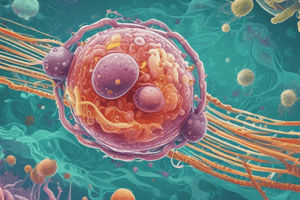Podcast
Questions and Answers
Which cellular process is characterized by the preservation of cellular outlines with loss of nuclei and an inflammatory infiltrate, as seen in a kidney infarct?
Which cellular process is characterized by the preservation of cellular outlines with loss of nuclei and an inflammatory infiltrate, as seen in a kidney infarct?
- Fat necrosis, typically occurring after traumatic injury to tissue with high fat content.
- Caseous necrosis, marked by a cheese-like appearance and commonly found in fungal infections.
- Coagulative necrosis, resulting from ischemia and characterized by protein denaturation. (correct)
- Liquefactive necrosis, due to rapid enzymatic digestion of cells and tissues.
In pathology, what is the crucial fate of a cell that cannot adapt to stress and sustains irreversible injury?
In pathology, what is the crucial fate of a cell that cannot adapt to stress and sustains irreversible injury?
- Transition into a quiescent state characterized by reduced metabolic activity and temporary cell cycle arrest.
- Cell death via necrosis or apoptosis, leading to the release of cellular contents into the extracellular space. (correct)
- Reversion to a less differentiated state with altered gene expression patterns to enhance survival.
- Initiation of cellular repair mechanisms involving increased protein synthesis and organelle biogenesis.
A pathologist is examining a tissue sample and observes an area of necrosis with complete structural disorganization and lysosomal enzyme digestion. Which type of necrosis is most likely?
A pathologist is examining a tissue sample and observes an area of necrosis with complete structural disorganization and lysosomal enzyme digestion. Which type of necrosis is most likely?
- Coagulative Necrosis
- Fibrinous Necrosis
- Fat Necrosis
- Liquefactive Necrosis (correct)
Which form of cell death is typically associated with inflammation, cellular swelling, and rupture of the cell membrane?
Which form of cell death is typically associated with inflammation, cellular swelling, and rupture of the cell membrane?
In the context of cell injury, what key event signifies the point of irreversibility, leading a cell towards necrosis rather than recovery?
In the context of cell injury, what key event signifies the point of irreversibility, leading a cell towards necrosis rather than recovery?
Which alteration in cellular morphology most strongly suggests a cell has progressed beyond reversible injury into cellular necrosis?
Which alteration in cellular morphology most strongly suggests a cell has progressed beyond reversible injury into cellular necrosis?
A researcher is studying cell injury and observes a cell with a pyknotic nucleus. What cellular process has initiated this change?
A researcher is studying cell injury and observes a cell with a pyknotic nucleus. What cellular process has initiated this change?
Which of the following cellular changes observed under a microscope indicates that a cell has undergone irreversible injury and is undergoing necrosis, rather than merely adapting to stress?
Which of the following cellular changes observed under a microscope indicates that a cell has undergone irreversible injury and is undergoing necrosis, rather than merely adapting to stress?
What is the significance of increased eosinophilia observed in cells undergoing necrosis?
What is the significance of increased eosinophilia observed in cells undergoing necrosis?
Why does irreversible cell injury lead to decreased basophilia?
Why does irreversible cell injury lead to decreased basophilia?
In the context of reversible cell injury, what is the primary mechanism leading to cellular swelling (hydropic change)?
In the context of reversible cell injury, what is the primary mechanism leading to cellular swelling (hydropic change)?
What is the critical significance of mitochondrial amorphous densities that appear during cell injury progression?
What is the critical significance of mitochondrial amorphous densities that appear during cell injury progression?
Which aspect of a disease process is most directly concerned with the underlying causes?
Which aspect of a disease process is most directly concerned with the underlying causes?
During reversible cell injury, detachment of polysomes from the endoplasmic reticulum occurs. How does this alteration affect the cell?
During reversible cell injury, detachment of polysomes from the endoplasmic reticulum occurs. How does this alteration affect the cell?
How does pathology serve as a bridge between basic sciences and clinical medicine?
How does pathology serve as a bridge between basic sciences and clinical medicine?
In the context of cell injury, how do chaperones primarily function?
In the context of cell injury, how do chaperones primarily function?
Which of the following best illustrates the role of pathology in guiding the treatment of disease?
Which of the following best illustrates the role of pathology in guiding the treatment of disease?
What is the primary role of ubiquitin in the context of cell injury and protein homeostasis?
What is the primary role of ubiquitin in the context of cell injury and protein homeostasis?
How does systemic pathology differ from general pathology?
How does systemic pathology differ from general pathology?
If a cell undergoes metaplasia as an adaptation to stress, what is the most accurate description of this process?
If a cell undergoes metaplasia as an adaptation to stress, what is the most accurate description of this process?
What role do ion channels play in the context of cell injury, particularly regarding reversible cell injury?
What role do ion channels play in the context of cell injury, particularly regarding reversible cell injury?
Flashcards
Necrosis
Necrosis
Cell death due to irreversible injury, differing morphologically from apoptosis.
Pathology
Pathology
The study of disease, examining structural, biochemical, and functional changes in cells, tissues, and organs.
Pathology Tools
Pathology Tools
Uses molecular, microbiologic, immunologic, and morphologic techniques to explain patient signs and symptoms, providing a basis for clinical care.
Coagulative Necrosis
Coagulative Necrosis
Signup and view all the flashcards
Cell Death
Cell Death
Signup and view all the flashcards
Four Aspects of Disease
Four Aspects of Disease
Signup and view all the flashcards
Microscopic View of Coagulative Necrosis
Microscopic View of Coagulative Necrosis
Signup and view all the flashcards
Systemic Pathology
Systemic Pathology
Signup and view all the flashcards
Cell Response to Stress
Cell Response to Stress
Signup and view all the flashcards
Pathology in Practice
Pathology in Practice
Signup and view all the flashcards
Cell Injury
Cell Injury
Signup and view all the flashcards
Cell Adaptations
Cell Adaptations
Signup and view all the flashcards
Atrophy
Atrophy
Signup and view all the flashcards
Reversible Cell Injury
Reversible Cell Injury
Signup and view all the flashcards
Factors Determining Injury Outcome
Factors Determining Injury Outcome
Signup and view all the flashcards
Reversible: Membrane Alterations
Reversible: Membrane Alterations
Signup and view all the flashcards
Reversible: Hydropic Change
Reversible: Hydropic Change
Signup and view all the flashcards
Irreversible Cell Injury
Irreversible Cell Injury
Signup and view all the flashcards
Irreversible: Increased Eosinophilia
Irreversible: Increased Eosinophilia
Signup and view all the flashcards
Pyknosis
Pyknosis
Signup and view all the flashcards
Karyolysis
Karyolysis
Signup and view all the flashcards
Study Notes
Contact Information
- Broderick C. Jones has a phone number of 954-262-1325.
- Broderick C. Jones' office is located at 1325 Terry.
- Broderick C. Jones' email is [email protected].
Pathology
- Pathology is the study of disease.
- Pathology examines structural, biochemical, and functional changes in cells, tissues, and organs that underlie disease.
- Pathology uses molecular, microbiologic, immunologic, and morphologic tools and techniques.
- Pathology explains patient symptoms and provides a rational basis for clinical care and therapy.
- Four aspects of a disease process include etiology, pathogenesis, morphology, & clinical Importance.
- Pathology can be divided into general and systemic pathology.
- Systemic pathology includes cardiovascular, hematopathology, respiratory, gastrointestinal, renal, reproductive, endocrine, dermatopathology, musculoskeletal, and central nervous system.
- Pathology is used for the diagnosis and to guide the treatment of disease.
- Pathology diagnostic methods include autopsy, tissue examination, and clinical laboratory testing.
Cell Injury
- Cell injury and death can be caused by injurious stimuli.
- Following stress or an injurious stimulus, a normal cell can undergo adaptation or cell injury if unable to adapt or the extent of the stress exceeds its adaptive capacity.
Cell Adaptations
- Adaptations are responses to changes in cell environments.
- Adaptations can include reversible changes in size, number, phenotype, metabolic activity, and functions.
- Types of cell adaptations: atrophy, hypertrophy, hyperplasia, metaplasia, intracellular accumulation, aging.
Atrophy
- Atrophy refers to the reduced size of an organ or tissue.
- Atrophy results from a decrease in cell size and/or number.
- Decrease in cell size.
- JL's case includes multi-infarct dementia, Alzheimer's disease, and Parkinson's disease.
- Physiological atrophy in uterus size reduction after delivery.
- Pathological atrophy involves a decrease in cell size, decreased workload, loss of innervation, diminished blood supply, inadequate nutrition, loss of endocrine stimulation, local pressure, denervation, and autophagy.
- Mechanisms of atrophy involve intracellular factors such as decreased protein synthesis/increased protein degradation.
- Cellular protein degradation by ubiquitin-proteasome pathways.
Autophagy
- With Autophagy, starved cells resort to cannibalism for survival.
- Undigested cell debris creates lipofuscin granules.
- Cellular stresses such as nutrient deprivation activate an autophagy pathway
- The autophagy pathway proceeds through several phases of initiation, nucleation, and elongation of isolation membrane.
- It creates double-membrane-bound vacuoles (autophagosomes) in which the cytoplasmic materials are sequestered. It is then degraded after fusion of the vesicles with lysosomes.
- Digested materials are released for recycling of metabolites.
Hypertrophy
- Hypertrophy is the enlargement of cells.
- Hypertrophy results from increase in the size of cells, resulting in increased size of the organ.
- It is due to synthesis of more structural components. It can be:
- Physiological
- Pathological
- Physiological factors are growth factors that include transforming growth factor (TGF-β), Insulin-like growth factor-1 [IGF-1], Fibroblast growth factor & Vasoactive agents such as a-adrenergic agonists, Endothelin-1 & Angiotensin II
Hyperplasia
- Hyperplasia is the increase in cell numbers.
- Increase in cell numbers can be hormonal, compensatory, or physiological.
- Physiological factors include the breast, puberty, and pregnancy
- Pathological factors include the uterus (endometrial hyperplasia), psoriasis, and prostate (BPH).
Metaplasia
- Metaplasia involves stem cell reprogramming.
- Stem cells exist in normal tissues.
- Undifferentiated mesenchymal cells are present in connective tissue.
- Metaplasia is reversible and represents an adaptive substitution of cells.
- Stimuli promotes gene expression.
- Cells are driven toward a specific differentiation pathway and are resistant to a harsh environment.
- Differentiation factors include cytokines, growth factors, and extracellular matrix components.
Intracellular Accumulations
- Intracellular Accumulations are metabolic derangements leading to accumulation of abnormal amounts of substances.
- They are caused by abnormal metabolism, protein folding and transport, lack of an enzyme, or ingestion of indigestible material.
- Intracellular Accumulations can be lipids, cholesterol, proteins, glycogen, or pigments.
- Result of abnormal metabolism.
- Triglyceride accumulation increases reduced NAD, and defective export.
- Liver/steatosis.
Cell Injury & Death Factors
- The causes of cell injury include: oxygen deprivation (hypoxia), physical agents, chemical agents and drugs, infectious agents, immunological reactions, genetic derangements, and nutritional imbalances. How do these adverse stimuli injure cells and what is the mechanism?
Mechanisms of Cell Injury
- The mechanisms of cell injury include loss of ATP, mitochondrial damage, influx of calcium, free radical accumulation, damage to DNA and proteins, and membrane damage.
- Cascade of events (ischemia) leading to cellular and organelle swelling.
- Increase anaerobic glycolysis, decreases glycogen, and pH, leading to clumping of chromatin and enzyme function abnormalities.
- Cell factors consist of type, state, and adaptability.
- Assess biochemical mechanisms.
- Determine if cellular damage is reversible or irreversible.
Reversible Cell Injury
- Reversible cell injury involves plasma membrane alterations.
- This includes Blebbing, Blunting & Loss of microvilli.
- It can result to Mitochondrial changes. such as swelling and/or appearance of small amorphous densities.
- Cellular swelling and increased vacuoles
- Dilation of the ER
- Detachment of polysomes
- Intracytoplasmic myelin
- Nuclear alterations
- Disaggregation of granular and fibrillar elements
Irreversible Cell Injury
- Increased eosinophilia involving denaturation of proteins
- Myelin figures accumulate due to damaged cellular membranes
- Mitochondrial amorphous densities increase
- Nuclear changes such as Pyknosis, Karyolysis and Karyorrhexis.
Cell Death
- If a cell cannot adapt and becomes irreversibly injured, it must die or undergo necrosis.
- Cell death includes Necrosis & Apoptosis.
- Types of cell death include:
- Coagulative Necrosis
- Liquefactive Necrosis
- Caseous Necrosis
- Fat Necrosis
- Fibrinous
- Gangrenous
- Apoptosis
Coagulative Necrosis
- Coagulative necrosis are wedge-shaped kidney infarcts.
- Microscopic view of the edge of the infarct, with normal kidney (N) and necrotic cells in the infarct (I) preserves cellular outlines with loss of nuclei and an inflammatory infiltrate as nuclei of inflammatory cells in between necrotic tubules.
Liquefactive Necrosis
- Liquefactive Necrosis Occurs in focal bacterial or, occasionally, fungal infections. Accumulation of leukocytes
- Liberation of enzymes
- Tissue results in a Liquid viscous mass
- Digestion of dead cells
- Infarction of brain
Caseous Necrosis
- Caseous necrosis appears "cheeselike".
- It consists of friable white arreas of necrosis, forming a focus of Inflammation & Granulomas
- Granuloma - Collection of fragmented cells, Amorphous granular debris, Enclosed within an inflammatory border.
Fat Necrosis
- Fat necrosis occurs with acute pancreatitis.
- Pancreatic lipases are released into the peritoneal cavity.
- Lipases liquefy the membranes of fat cells in the peritoneum.
- Fatty acids combine with calcium, producing visible chalky-white areas by fat saponification.
Fibrinous Necrosis
- Fibrinous necrosis involves blood vessels.
- Involves antigen and antibody deposition in arterial walls.
- Immune complexes & it becomes Pro-inflammatory.
- Produces a bright pink amorphous deposit in vessel walls.
Gangrenous Necrosis
- Gangrenous Necrosis refers to an infarcted limb involving multiple tissue planes.
- Includes superimposed bacterial infection.
- It can produce a liquefactive necrosis.
Apoptosis
- Apoptosis is a tightly regulated suicide pathway program.
- Apoptosis involves the elimination of cells no longer needed and maintains a steady number of various cell populations in tissues.
- Programmed destruction of cells during embryogenesis (Physiological).
- Involution of hormone-dependent tissues upon hormone withdrawal (Physiological).
- Pathological Apoptosis eliminates cells injured beyond repair/includes DNA damage, accumulation of mis-folded proteins, & cells infected by viruses.
Morphologic Featires of Apoptosis
- Cell shrinkage
- Chromatin condensation
- Formation of cytoplasmic blebs and apoptotic bodies
- Phagocytosis of apoptotic cells or cell bodies, by macrophages
Apoptosis Mechanism
- Includes Intrinsic (Mitochondrial Pathway) & Extrinsic (Death receptor-Initiated Pathway) Intrisnic is activated by:
- Lack of growth and survival signals / injury
- Activate Bim, Bid, and Bad sensors
- Bim, Bid, and Bad activate Bax and Bak
- Bax and Bak insert channels into Mitochondrial leakage of cytochrome C Cytochrome C activation of caspases 9 and others
- Executioner caspases activation
Apoptosis:Death Receptor Initiated Pathway
FasL to Fas binding Cytoplasmic domains form a binding site for FADD FADD activates caspase 8 and other caspases
Apoptosis: Execution Phase
- Activated Caspases (3 and 6) which act on many cellular components and indirectly activate DNase.
- Cleavage of DNA into nucleosome-sized pieces
- Executioner Caspases cause Degradation and fragmentation of nuclear matrix
Necroptosis
- Necroptosis is caspase-independent.
- Depends on the RIPK1 and and RIPK3 complex.
- RIPK1-RIPK3 signaling leads to Phosphorylation of MLKL, which then forms pores in the plasma membrane.
Pathologic Calcification
- Pathologic Calcification refers to: Abnormal Tissue Deposition of Calcium salts, Iron, Magnesium, and other mineral salts.
- Types can be:
- Dystrophic calcification
- Metastatic calcification
- Pathogenesis involves Memberane Damage where Ca+2 binds to the phospholipids in membrane vesicles, then Phosphate groups bind calcium and Ca+2 and phosphate binding cycle repeated.
Dystrophic Calcification
- Dystrophic calcification is encountered in areas of necrosis and Macroscopic formations of Fine, white granules or clumps, gritty deposits
Metastatic Calcification
- Metastatic calcification Results from conditions that produce Primary causes of Hypercalcemia.
- Increased secretion of Parathyroid Hormone (PTH) , with Ectopic secretion, PTH-related protein by malignant tumors
- Destruction of Bone tissue such as Secondary to primary tumors of bone marrow multiple myeloma, leukemia and Diffuse skeletal metastasis of breast cancer.
- Vitamin D Related Disorders
- Renal Failure Causes retention of phosphate, leading to secondary hyperparathyroidism.
- Metastatic calcification occurs widely throughout the body, affects Interstitial Tissues such as Gastric mucosa, Kidneys, Lungs, Systemic arteries and Pulmonary veins.
- These tissues excrete acid, forming a alkaline compartment, predisposing them to metastatic calcification
Studying That Suits You
Use AI to generate personalized quizzes and flashcards to suit your learning preferences.





